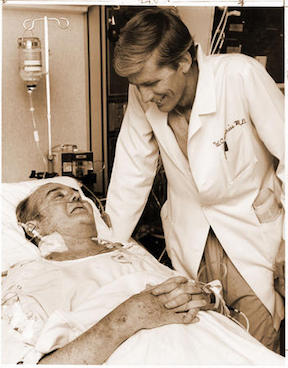Difference between revisions of "Barney Clark"
(Created page with "300px|thumb|left '''Barney Clark''' was a dentist from Seattle with congestive heart failure. He was ineligible for a heart transplant, but on Dece...") |
|||
| Line 10: | Line 10: | ||
| − | [[Category: | + | [[Category:Famous Mormons]] |
Revision as of 17:11, 4 February 2019
Barney Clark was a dentist from Seattle with congestive heart failure. He was ineligible for a heart transplant, but on December 2, 1982, he made history by being the world’s first recipient of an artificial heart, intended to be permanent. Latter-day Saint heart surgeon William DeVries and his team implanted the FDA-approved Jarvik 7 in Clark’s chest.
Clark lived for another 112 days, dying on March 23, 1983. His widow, Una Loy, said he “believed in the artificial-heart concept and wanted to make a contribution.” His remaining days, spent in a hospital bed at the University of Utah Medical Center, were complex, as he was attached to a 350-pound compressor that powered his heart and pumped compressed air in and out of his body that made him suffer considerably. He was in and out of consciousness; experienced memory lapses; had convulsions; and his kidneys failed him. The hospital pronounced his cause of death as “circulatory collapse and secondary multiorgan system failure.”[1] The procedure and Clark’s death stirred up issues of bioethics.
After his death, five more men received Jarvik-7 artificial hearts, the longest surviving 620 days. The Jarvik-7 that was placed in the sixth recipient is in the permanent collection of the Smithsonian Museum. Its creator, Robert K. Jarvik, had decided to study medicine and engineering after his father died of heart disease. By 1982, he was conducting animal trials at the University of Utah with his Jarvik-7 artificial heart.
- During the next decade, Jarvik and others concentrated their efforts on developing mechanical pumps to assist a diseased heart rather than replace it. These devices allow many patients to live the months or even years it takes for them to find a donor heart. Battery powered, these implants give heart-disease patients mobility and allow them to live relatively normal lives. Meanwhile, in the 1990s, the Jarvik-7 was used on more than 150 patients whose hearts were too damaged to be aided by the mechanical pump implant. More than half of these patients survived until they got a transplant.[2]
